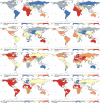Compound impact of COVID-19, economy and climate on the spatial distribution of global agriculture and food security
- PMID: 36972878
- PMCID: PMC10039698
- DOI: 10.1016/j.scitotenv.2023.163105
Compound impact of COVID-19, economy and climate on the spatial distribution of global agriculture and food security
Abstract
As the COVID-19 pandemic continues to unfold around the world, the per unit area yield of the world's three major crops (i.e. maize, rice and wheat) decreased simultaneously for the first time in 20 years, and nearly 2.37 billion people faced food insecurity in 2020. Around 119-124 million people were pushed back into extreme poverty. Drought is one of the natural hazards that mostly affect agricultural production, and 2020 is one of the three warmest years on record. When the pandemic, economic recession and extreme climate change occur simultaneously, food crisis will often be exacerbated. Due to the limited research on the geographic modelling of crops and food security at the country level, we investigated the effects of the COVID-19 pandemic (COVID-19 incidence and mortality rate), economic (GDP and per capita GDP), climate (temperature change and drought), and their compound effects on three crop yields and food security in the world. On the basis of verifying the spatial autocorrelation, we used the global ordinary least squares model to select the explanatory variables. Then, geographically weighted regression (GWR) and multi-scale GWR (MGWR), were utilised to explore spatial non-stationary relationships. Results indicated that the MGWR was more efficient than the traditional GWR. On the whole, per capita GDP was the most important explanatory variable for most countries. However, the direct threats of COVID-19, temperature change and drought on crops and food security were small and localised. This study is the first to utilise advanced spatial methods to analyse the impacts of natural and human disasters on agriculture and food security in various countries, which can serve as a geographical guide for the World Food Organization, other relief agencies and policymakers to conduct food aid, health and medical assistance, financial support, climate change policy formulation, and anti-epidemic policy formulation.
Keywords: Agricultural yield; COVID-19; Climate; Economy; Food security; MGWR.
Copyright © 2023. Published by Elsevier B.V.
Conflict of interest statement
Declaration of competing interest We acknowledge that our manuscript is original and it is not submitted for review in another journal. We have provided references for the data set used in our study. The authors declare that they have no known competing financial interests or personal relationships that could have appeared to influence the work reported in this paper.
Figures











References
-
- Anselin L., Arribas-Bel D. Spatial fixed effects and spatial dependence in a single cross-section: spatial fixed effects and spatial dependence. Pap. Reg. Sci. 2013;92:3–17. doi: 10.1111/j.1435-5957.2012.00480.x. - DOI
-
- Brunsdon C., Fotheringham A.S., Charlton M.E. Geographically weighted regression: a method for exploring spatial nonstationarity. Geogr. Anal. 2010;28:281–298. doi: 10.1111/j.1538-4632.1996.tb00936.x. - DOI
-
- Dai A., Trenberth K.E., Qian T. A global dataset of palmer drought severity index for 1870–2002: relationship with soil moisture and effects of surface warming. J. Hydrometeorol. 2004;5:1117–1130. doi: 10.1175/JHM-386.1. - DOI
MeSH terms
LinkOut - more resources
Full Text Sources
Medical
Research Materials

